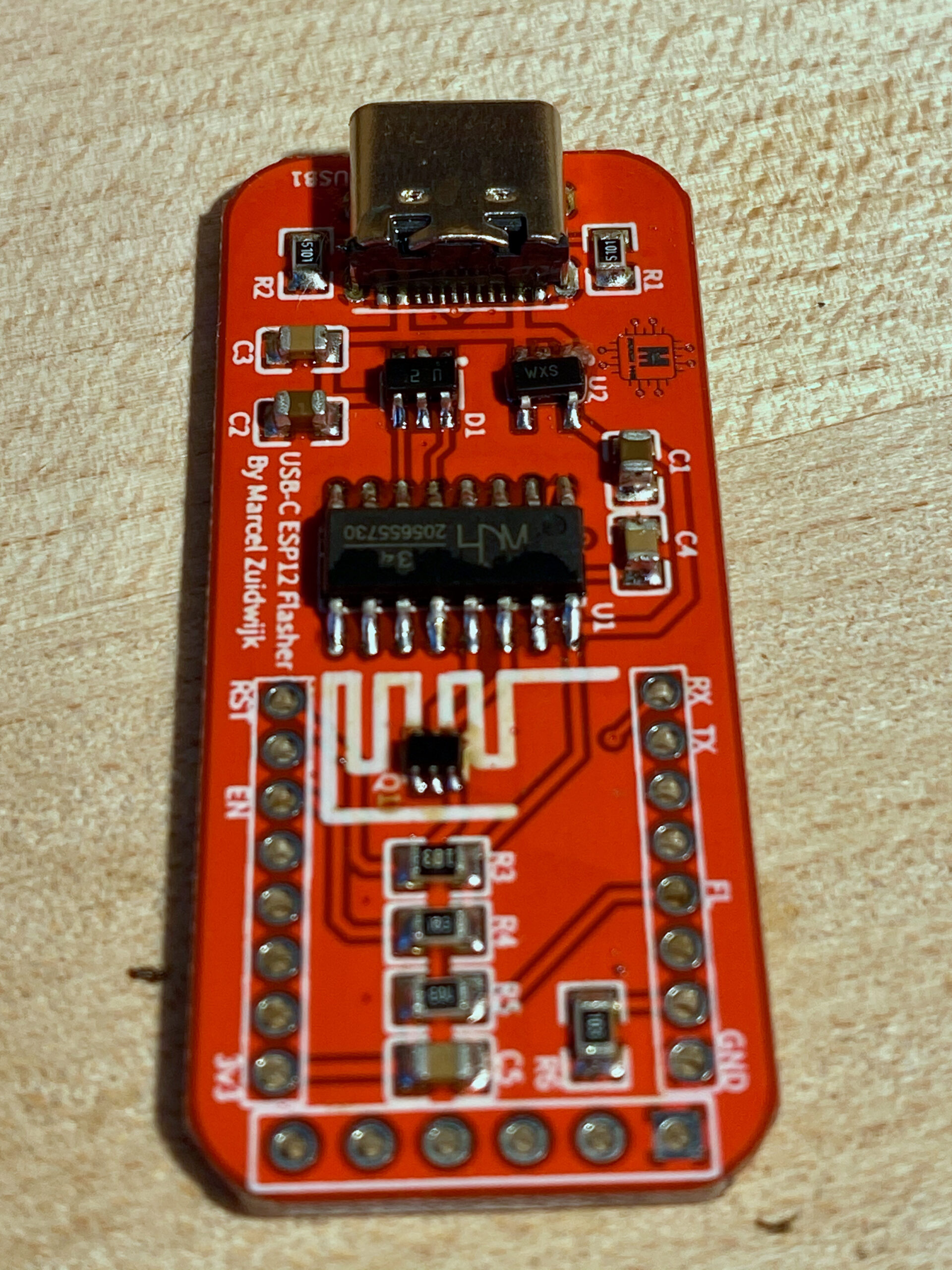Today, finally the mailman came to deliver the last few parts for a project: ESP12-Flasher. An easy hat to quickly flash an ESP12. While soldering, the doorbell rang again, another delivery service with a package: a forgotten prototype of a P1 reader 😂
#1 ESP12 Flasher
So today the last few parts arrived to be able to build me a ESP12 Flasher. I want to be able to quickly flash an esp12 type (like Wemos D1 mini v1, or custom board like my Compact reader). The idea is to place this flasher on top of the esp and flash it quickly without connect and disconnect the USB cable (kinda handy when flashing large amounts of readers). Unfortunately the pogo pins didn’t arrived yet.



The left photo is before the hot plate. PCB, solder paste and the components. The most tricky part is the USB C 16 pins connector, I mean, that is T-I-N-Y!! The middle photo is after the hot plate. The 16 pins had a little too much solder, so that needed to be corrected with flux (can’t life without that!). The right photo is the correction with flux.
#2 The “forgotten” P1 reader prototype
I wanted to test several things and settings. Therefore I needed an easy to make pcb and easy to flash (and there steps the previous project in 😉). As part of a project in the near feature, I want to play more with ESPHome. Off course I can do that on the previous Wemos versions. Yet there the components are soldered between the pcb and the Wemos. Not handy for troubleshooting. So I created a test reader for that (and got now 49 pcb’s left 🤣).
And because it is a prototype, I wanted to use another color: Blue (hint). I’ve never ordered the blue pcb’s at JLCPCB before, and must say that I like the color! The most important feature is to be able to bypass the inverter (and have the opportunity to use the inverter within the ESP12 itself.






No pogo pins…
Unfortunately I didn’t received my ordered pogo pins. So I had to test the ESP-Flasher with some wires and a 6-pin header (to automate the flash procedure. Gnd, vcc, rx, tx, rst and flash). Well, that worked perfectly 😍 So I can’t wait to receive the pogo pins next year and finish the ESP-Flasher project.
For now… I’d like to wish you all a happy new year! That 2021 may be a better year than 2020 was, and we all may be healthier and we finally can beat COVID.











admin
Hi,
I would like to buy a P1 reader – WiFi version. My goal is to interface it to Jeedom (the box domotic). I already did an interface in the past between Jeedom and one ESP8266 through ESP Easy. Is it that kind of firmware ? If so, I will be able to install it in Jeedom for sure.
Thanks
Marcel
Hi,
You can flash it with any firmware you like, it is an Wemos D1 mini on it.
I deliver it with esp-link (3.0.14) which makes it a tcp/telnet server.
Ill send you an email for further details ☺️
elRadix
Hi,
Does this P1 reader work with the belgian fluvuis digital meter? https://www.fluvius.be/nl/thema/meters-en-meterstanden/activeer-desactiveer-je-gebruikerspoorten
How does the reader get powered?
Marcel
Hi, yes indeed, it does work with Belgium meters (already sold many towards people in Belgium). There is a small difference between Dutch and Belgium DSMR code, and that is a few different id’s used in the telegrams. If you’re going to use ESPHome, you need to select the right library. If you’re using esp-link, than you’ll get all the data via the tcp/telnet server and will the logging software sort out which ids it’ll take. I’ll mail you for more information 😌
VDV Eric
Hallo,
ik ben geïnteresseerd in uw ontwikkeling. Ik heb een JEEDOM-server om de rollen van het huis te beheren. Nu de Vlaamse overheid het gebruik van de omkeermeter verbiedt, ben ik op zoek naar een oplossing om te meten wanneer de zonnenpannelen injecteert in het net, en direct een relais te gebruiken om bijvoorbeeld de boiler te starten. Wat denk je ?
Marcel
Hoi Eric, je bent de tweede die mij benadert en Jeedom gebruikt. Ik ken het een beetje, maar heb het zelf niet lekker aan de praat kunnen krijgen. Ik ben zelf een grote voorstander van Home Assistant. Mijn readers spugen de telegrams van de P1 poort (de meter) via een telnet/tcp-server het netwerk op. Als Jeedom daarmee overweg kan, kan je het integreren en gebruiken. Echter kan ik dat niet voor je testen.